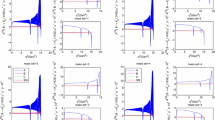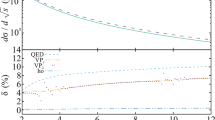Abstract
In this paper, we study lepton pair production with polarized electron-positron beams in the context of the non-commutative standard model, an extension of the standard model based on non-commutative geometry. By employing the Seiberg–Witten map, we compute the production cross-section up to first order in the non-commutative parameter \({{\Theta }_{{\mu \nu }}}\). In our analysis we use the same value for both space-space and time-space non-commutative parameter, and we focus on collision energies in the range 300–1000 GeV, appropriate for the future ILC collider. Our main objectives are to examine the angular distribution \({{{\text{d}}\sigma } \mathord{\left/ {\vphantom {{{\text{d}}\sigma } {{\text{d}}\Omega }}} \right. \kern-0em} {{\text{d}}\Omega }}\) and the total cross-section, aiming to explore the effects of space-time non-commutativity at an energy scale around \(\Lambda \sim {\text{TeV}}\) and the possibility of observing these effect at the ILC. Our results indicate a significant deviation in the angular distribution due to non-commutativity when \(\Lambda \sim {{10}^{3}}{\kern 1pt} {\text{GeV}}\). Moreover, the total cross-section for lepton pair production is more sensitive to space-time deformations in the polarized case compared to the unpolarized case. Specifically, we find that at center-of-mass energy \(\sqrt s = 1000{\kern 1pt} \,{\text{GeV}}\), the deviation in the polarized case is approximately eight times larger than that in the unpolarized case. We also estimate from this study a bound on the scale of the non-commutative parameter \(\Lambda \).





Similar content being viewed by others
Notes
It is important to note that our general arguments and conclusions remain unaffected by this specific choice.
REFERENCES
A. Alboteanu, T. Ohl, and R. Ruckl, “The noncommutative standard model at \(\mathcal{O}\)(θ2),” Phys. Rev. D 76, 105018 (2007), arXiv:0707.3595 hep-ph.
X. Calmet, B. Jurco, P. Schupp, J. Wess, and M. Wohlgenannt, “The Standard model on noncommutative space-time,” Eur. Phys. J. C 23, 363–376 (2002), arXiv: hep-ph/0111115.
M. Chaichian, P. Presnajder, M. M. Sheikh-Jabbari, and A. Tureanu, “Noncommutative standard model: Model building,” Eur. Phys. J. C 29, 413–432 (2003), arXiv:hep-th/0107055.
J. L. Hewett, F. J. Petriello, and T. G. Rizzo, “Signals for noncommutative interactions at linear colliders,” Phys. Rev. D 64, 075012 (2001), arXiv:hep-ph/0010354.
J. L. Hewett, F. J. Petriello, and T. G. Rizzo, “Signals for noncommutative QED at high-energy e + e − colliders,” eConf C010630, E3064 (2001). arXiv:hep-ph/0201275.
S. Godfrey and M. A. Doncheski, “Signals for noncommutative QED in eγ and γγ collisions,” Phys. Rev. D 65, 015005 (2002). arXiv:hep-ph/0108268.
R. Horvat, D. Latas, J. Trampetić, and J. You, “Light-by-light scattering and spacetime noncommutativity,” Phys. Rev. D 101, 095035 (2020). arXiv:2002.01829 hep-ph.
S. C. Inan and A. V. Kisselev, “Search for noncommutative interactions in γγ → γγ process at the LHC,” Eur. Phys. J. C 82, 845 (2022), arXiv:2203.03332 hep-ph.
A. Prakash, A. Mitra, and P. K. Das, “e + e − → µ+µ− scattering in the noncommutative standard model,” Phys. Rev. D 82, 055020 (2010), arXiv:1009.3554 hep-ph.
P. K. Das and A. Prakash, “Laboratory frame analysis of e + e − → µ+µ− scattering in the noncommutative standard model,” Int. J. Mod. Phys. A 27, 1250141 (2012), arXiv:1112.0943 hep-ph.
G. Abbiendi et al. (OPAL Collab.), “Test of noncommutative QED in the process e + e − → γγ at LEP,” Phys. Lett. B 568, 181–190 (2003), arXiv:hep-ex/0303035.
D. Latas, J. Trampetić, and J. You, “Seiberg–Witten map invariant scatterings,” Phys. Rev. D 104, 015021 (2021), arXiv:2012.07891 hep-ph.
J. Selvaganapathy, P. K. Das, and P. Konar, “Drell-Yan process as an avenue to test noncommutative standard model at the Large Hadron Collider,” Phys. Rev. D 93, 116003 (2016), arXiv:1602.02997 hep-ph.
M. El Arebi Gadja, L. Khodja, and Y. Delenda, “Higgs pt distribution in Higgs + jet production at hadron colliders within the noncommutative effective standard model,” Mod. Phys. Lett. A 0, 2350038 (2023), arXiv: 2301.01184 hep-ph.
G. Aad et al. (ATLAS Collab.), “Measurement of the energy asymmetry in \(t\bar {t}j\) production at 13 TeV with the ATLAS experiment and interpretation in the SMEFT framework,” Eur. Phys. J. C 82, 374 (2022), arXiv: 2110.05453 hep-ex.
L. Evans and P. Bryant, “The Large Hadron Collider: accelerator and experiments,” J. Istrum. 3, S08001 (2008), arXiv:0806.1063 physics.acc-ph.
T. Behnke, J. E. Brau, B. Foster, J. Fuster, M. Harrison, J. M. Paterson, M. Peskin, M. Stanitzki, N. Walker, and H. Yamamoto, “The International Linear Collider technical design report, Volume 1: Executive summary,” (2013), arXiv:1306.6327 physics.acc-ph.
H. Baer et al. (ILC Collab.), “The International Linear Collider technical design report, Volume 2: Physics,” (2013), arXiv:1306.6352 hep-ph.
P. Bambade et al., “The International Linear Collider: a global project,” (2019), arXiv:1903.01629 hep-ex.
H. S. Snyder, “Quantized space-time,” Phys. Rev. 71, 38–41 (1947).
M. R. Douglas and N. A. Nekrasov, “Noncommutative field theory,” Rev. Mod. Phys. 73, 77–1029 (2001), arXiv:hep-th/0106048.
N. Seiberg and E. Witten, “String theory and noncommutative geometry,” J. High Energy Phys. 09, 032 (1999), arXiv:hep-th/9908142.
B. Melic, K. Passek-Kumericki, J. Trampetic, P. Schupp, and M. Wohlgenannt, “The Standard model on non-commutative space-time: Strong interactions included,” Eur. Phys. J. C 42, 499–504 (2005), arXiv: hep-ph/0503064.
F. Mandl and G. Shaw, Quantum Field Theory, 2nd ed. (Wiley, Hoboken, N.J, 2010).
M. Thomson, Modern Particle Physics (Cambridge University Press, New York, 2013).
Author information
Authors and Affiliations
Corresponding author
Ethics declarations
The author declares that he has no conflicts of interest.
Rights and permissions
About this article
Cite this article
Fisli, M. Lepton Pair Production in the Non-Commutative Standard Model with Polarized \({{e}^{ + }}{{e}^{ - }}\) Beams. Phys. Part. Nuclei Lett. 20, 1342–1349 (2023). https://doi.org/10.1134/S1547477123060122
Received:
Revised:
Accepted:
Published:
Issue Date:
DOI: https://doi.org/10.1134/S1547477123060122




